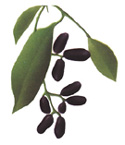| Latin Names | Syzygium cuminii (Linn.) Skeels syn. Eugenia jambolana Lam. (Myrtaceae) |
| English Names | Java plum, Jaman, Jambolan, Black plum |
| Sanskrit Names | Jambu, Rajajambu, Mahajambu |
| Hindi Names | Badijamun, Phadena |
 History: According to the Dirghama Sutra it is one of the four colossal mythical trees which make the four cardinal points standing to the south of Mount Meru; four great rivers rise at its base. The Vishnupurana states that the continent of Jambudvipa takes its name from this tree. Ibu Batuta, who visited India in 1332, mentions this as one of the fruits of Delhi. Dr. C. Graeser, of Bonn, in 1880’s, has published in the Central blatt fur klinische Medizin, an interesting account of a series of experiments on dogs with phloridzin-induced diabetes, with the extract of the fruit and the seeds of this plant.He concludes that the diabetes is considerably lessened by the seed extract, which is non-poisonous, and does not cause any ill effect. Distribution: Found throughout India up to an altitude of 1,800 m. Habit: S.c. is a large, evergreen tree. The bark is brown or greyish, smooth; the leaves, lanceolate, elliptic-oblong, coriaceous, gland-dotted, smooth and shiny; the flowers are greenish white, fragrant. The fruits are ellipsoid or oblong, black with pinkish juicy pulp; with single seeds. Principle constituents: S.c. contains malic acid, a small quantity of oxalic acid, gallic acid and tannins. Indications: The fruits form an ingredient of a preparation used against asthma. The seeds are hypoglycaemic. They also possess anti-inflammatory, anti-arthritic and antipyretic properties. Product range: Diabecon |
|